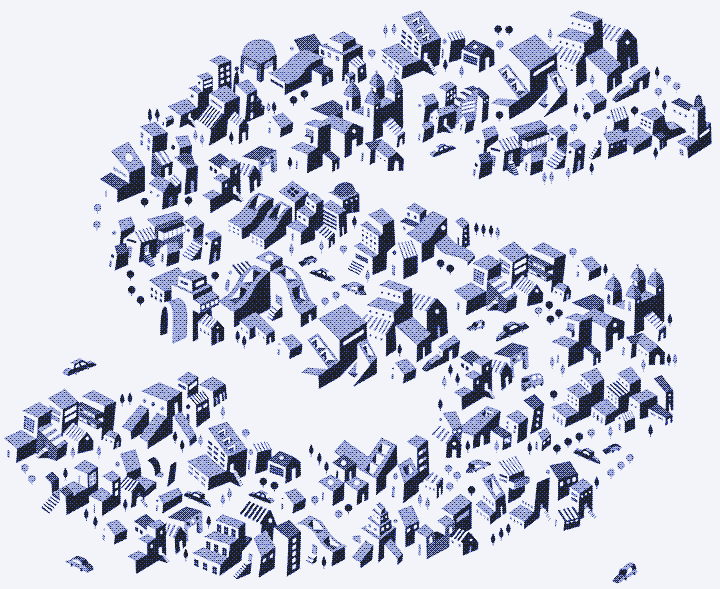
Architects all over the world have demonstrated the usefulness of buildings which are heated and cooled by design rather than by fossil fuel energy. What has received much less attention, however, is the possibility of applying this approach to entire urban neighbourhoods and cities.
Designing a single, often free-standing, passive solar house is quite different from planning a densely populated city where each building is heated and cooled using only natural energy sources. And yet, if we want passive solar design to be more than just a curiosity, this is exactly what we need. Modern research, which combines ancient knowledge with fast computing techniques, shows that passive solar cities are a realistic option, allowing for surprisingly high population densities.
Passive solar design has been around for thousands of years, and even predates the use of glass windows.
Passive solar design requires the knowledge to design and orientate buildings so that they can be heated by the sun. Coupled with other low-tech solutions such as thermal underwear –, heated clothing – and the creation of microclimates –, passive solar design could all but eliminate the use of fossil fuels and biomass for heating buildings throughout large parts of the world.
Indirectly, a passive solar house can also cancel the energy requirements for cooling and ventilation (passive cooling), and for lighting during the day. Of course, passive solar buildings can be outfitted with solar water heaters and PV solar panels, further reducing the use of unsustainable energy resources. Passive solar design does not involve any new technology. In fact, it has been around for thousands of years, and even predates the use of glass windows.
For most of human history, buildings were adapted to the local climate through a consideration of their location, orientation and shape, as well as the appropriate building materials. This resulted in many vernacular building styles in different parts of the world. In contrast, most modern buildings look the same wherever they stand. They are made from the same materials, they follow forms that are driven by fashion rather than by climate, and are most often randomly located and oriented, indifferent to the path of the sun and the prevailing wind conditions.

Modern buildings rely on a massive supply of cheap fossil fuels for heating, cooling, and lighting. Take the supply of cheap fossil fuels away, and they become completely uninhabitable for most of the year: they are too cold, too hot or too dark. This radical change in architectural design was caused by both the arrival of cheap and abundant energy sources and the resultant urbanisation (See part 2 —).
The Industrial Revolution relocated millions of people from the countryside to the cities. When most of us lived and worked on farms or in hamlets, it was fairly easy to orientate one’s house towards the sun. In an urban environment, however, building orientation is generally determined by street layout, and one building can easily overshadow another. High-rise buildings further complicate solar access.
From solar oriented buildings to solar oriented cities
This does not mean that passive solar design could not be applied to entire cities. It just takes more sophisticated planning. Solar access to an individual building is determined by only four factors: latitude (the distance north or south from the equator), slope, building shape and orientation.
Solar access to a city (or any other built-up environment) is determined by seven factors: the four just mentioned, plus the height of the buildings, the width of the streets, and the orientation of the streets (See part 2 —). Providing ventilation in an urban environment is determined by the same factors, with the exception that latitude is replaced by prevailing wind conditions.
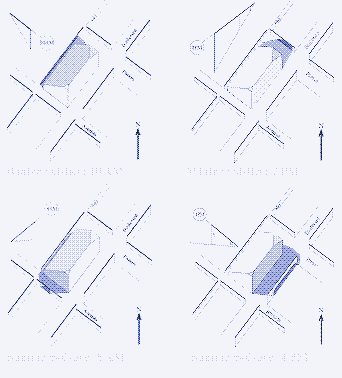
While most research in passive solar design during the 1970s was directed at individual buildings, one man began forty years of research into solar oriented cities: Ralph Knowles, professor emeritus at the USC’s School of Architecture and author of three fascinating books on the topic (1974, 1981, 2006).
Knowles developed and refined a method that strikes an optimal balance between population density and solar access: the “Solar Envelope”. It is a set of imaginary boundaries, enclosing a building site, that regulate development in relation to the sun’s motion—which is predictable throughout the seasons for any place on Earth.
Buildings within the solar envelope do not overshadow neighbouring buildings during critical energy-receiving periods of the day and the year
Buildings within this imaginary container do not overshadow neighbouring buildings during critical energy-receiving periods of the day and the season, and assure solar access for both passive and active solar systems. On the one hand, the solar envelope allows architects to design with sunlight without fear that their ideas will be cancelled out by future buildings. On the other hand, the solar envelope recognizes the need for development and high population densities, by defining the largest container of space that would not cast shadows off-site at specified times of the day.
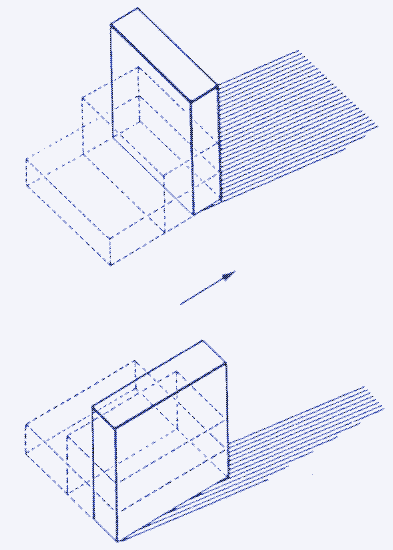
Knowles and his students have reached densities that are far above the average in European and American cities (See part 3 —), with the exception of high-rise centers such as Manhattan.
Modification of traditional zoning practices
The solar envelope is actually a relatively simple modification of existing zoning practices, which also set imaginary boundaries that enclose a building site—determining the maximum height, width and depth of future buildings. The most rigid approach in conventional zoning prescribes maximum building heights, set in feet or metres, number of floors, or both. A second, more flexible approach, sets limits based on a ratio between developeable land and floor area within the building on that site.
For example, a floor-to-area ratio (FAR) of 6 means that architects can develop 6 times the developeable square footage of land within the setbacks. They could cover the entire site with 6 stories, or cover only half of the site with 12 stories, for example.
Although both zoning methods offer a certain degree of solar access in a city, they are far from optimal. The main problem is that they do not design building orientation with its solar impact in mind, which can be as critical as building height. For example, a skyscraper with its broad flat sides facing east and west will cast a relatively small midday winter shadow, while one oriented with its broad flat sides facing north and south will shade a much larger area during the sunniest periods of the day (illustration above). Taking orientation into account would greatly improve solar access for surrounding buildings, without sacrificing housing density.
The geometry of the solar envelope
Compared to conventional zoning practices, the solar envelope produces a different geometry—the limits of the envelope derive their vertical dimensions from the sun’s daily and seasonal movements. Thus, while conventional zoning envelopes are shaped like a box, the solar envelope has both vertical and sloping spaces.
As a result, the buildings and city blocks that fill these imaginary solar envelopes are more likely to have unique shapes. One side of a building would not look like the other, nor would each side of the street. In the northern hemisphere, development would tend to be lower on the south side of a street than on the north where a major southern exposure would be preserved. Streets take on a directional character where solar orientation is clearly recognised.
Adjacent buildings can meet each other gently, rather than abruptly, across property sidelines. Tall buildings would group together at the site’s southwestern end, and those of moderate height at the northeastern end, with the shortest buildings taking up the site’s midsection. Buildings on corner lots will be taller because their shadows can extend accross the street in two directions instead of one.

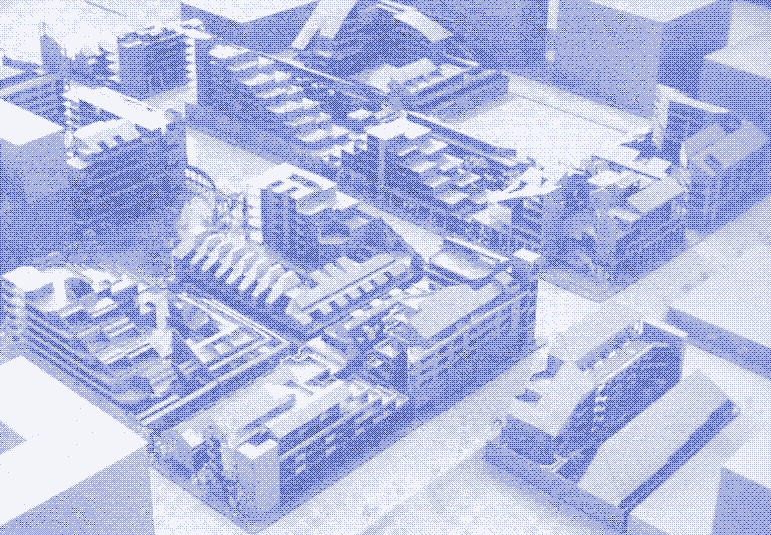
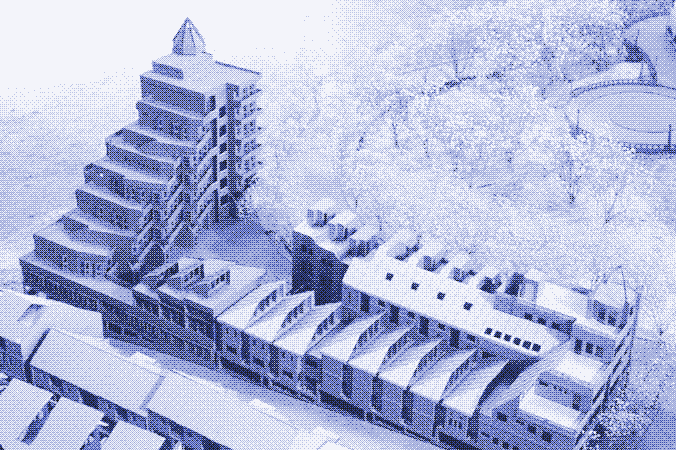
Within the solar envelope, certain architectural characteristics have great consistency. For instance, roof terraces appear where the sloping sides of the envelope intersect the rectilineair geometry of buildings. Courtyards are another crucial element, as they introduce sunlight and heat to deep interiors. Clerestories allow for the penetration of winter sun down stairways to enliven otherwise darker, lower floors. Sunscreens and porches are everywhere, keeping the sun out in summer.
Defining solar access
The solar envelope is not only defined by the path of the sun, but also by fixed parameters set by the designer. Choosing these will determine the balance between solar access and development potential.
The most important choice is the definition of the hours during which we want to avoid casting shadows on adjacent land—the ‘cut-off times’. The longer the period of daily solar access, the smaller the developeable volume under the envelope. Obviously, setting the cut-off times as equal to the period between sunrise and sunset would not work, because in that case few or any buildings could be constructed. For passive solar design, a minimum of 4 to 6 hours per day in winter is considered practical, depending on the climate.
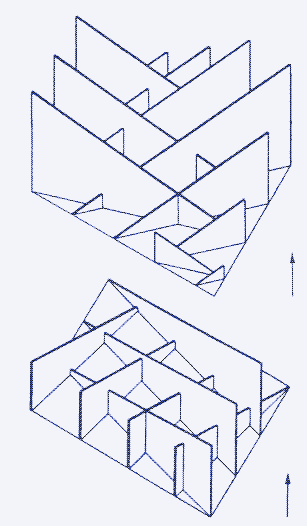
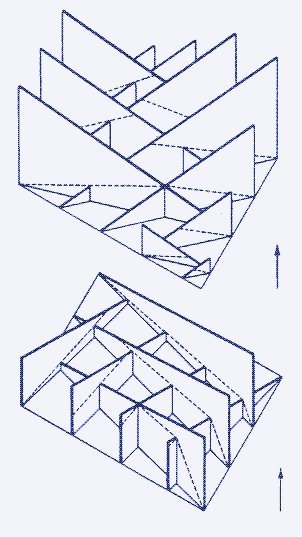
The duration of solar access could also be set by a minimum percentage of available energy instead of determining a minimum hours of sunshine. In that case, cut-off times would change over the course of the year. Another parameter to be set is the ‘shadow fence’. It determines the minimum height to which solar access has to be assured; for instance zero, 3 or 6 metres above street level. For example, one can choose to allow shadowing of garages and shops in order to improve the density under the solar envelope.
What about existing buildings?
Solar envelopes can be designed for individual buildings or as a single envelope for a group of houses, a neighbourhood, a district or even an entire city. This is a rather straightforward process when a site is being designed from scratch, but often current buildings will complicate the generation of a solar envelope. When the solar envelope is applied in line with existing buildings, new construction would always be shaped and proportioned with reference to the old. Each new phase of development changes the surroundings and thus the context within which the next envelope is generated.
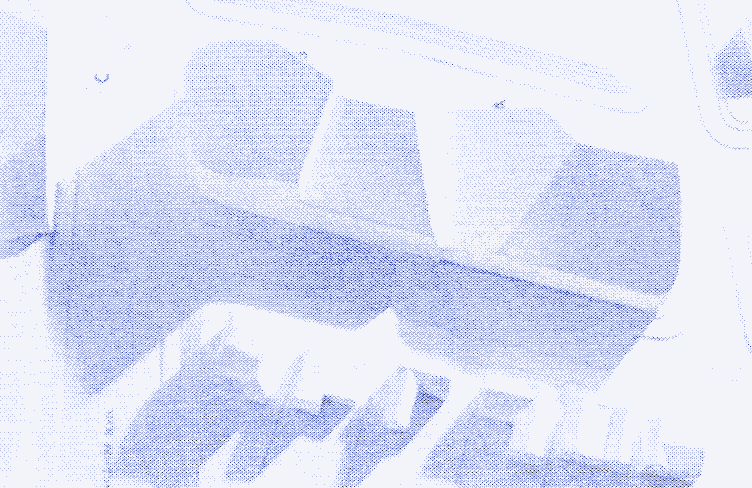

It is important to note that the solar envelope only protects neighbouring properties. It is the architect who must ensure solar access to the buildings within the envelope, tackling problems of overshadowing within the envelope itself. For larger sites, the volume of a solar envelope is therefore larger than the volume of the buildings that actually fill it, at least when solar access is assured to all dwellings on site.
Solar oriented cities in Antiquity
Knowles’ research draws on ancient knowledge, most notably the solar planned cities in Ancient Greece and the solar communities of the Ancient Pueblo People in what is today the Southwestern United States. The Ancient Greeks built entire cities which were optimal for solar exposure.
In the fifth century BC, for example, a neighbourhood for about 2500 people was built in the city of Olynthus. The streets were built perpendicular to each other, running long in the east-west direction (the horizontal streets shown in the plan below), so that all houses (five on each side of the street) could be built with southern exposure.
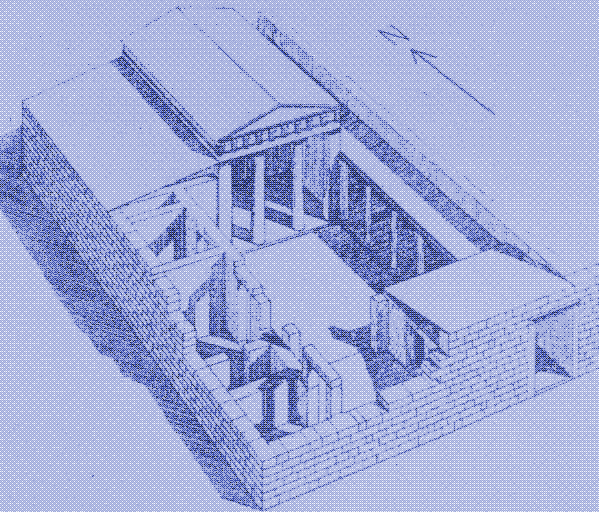
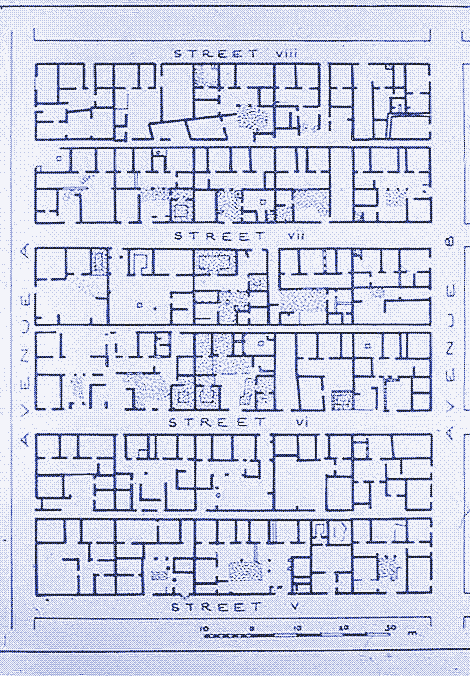
A gridirion street plan oriented at the cardinal points was not new at the time, and neither is it proof of a design aimed at maximum solar exposure. But the Greeks did more. In “*A Golden Thread: 2500 Years of Solar Architecture and Technology”, Ken Butti and John Perlin note that all houses were consistently built around a south-facing courtyard:
“The houses that faced south on the street and south to the sun were entered through the court, straight from the street. The houses that faced north to the street and south to the sun were entered through a passageway that led from the street through the main body of the house and into the court, from which access was gained to all other spaces.”
In keeping with the democratic ethos of the period, the height of buildings was strictly limited so that each courtyard received an equal amount of sunshine:
“In winter, rays from the sun traveling low across the southern sky streamed across the south-facing courts, throgh the portico, and into the house - heating the main rooms. The north walls were made of adobe bricks one and a half feet thick, which kept out the cold north winds of winter.”
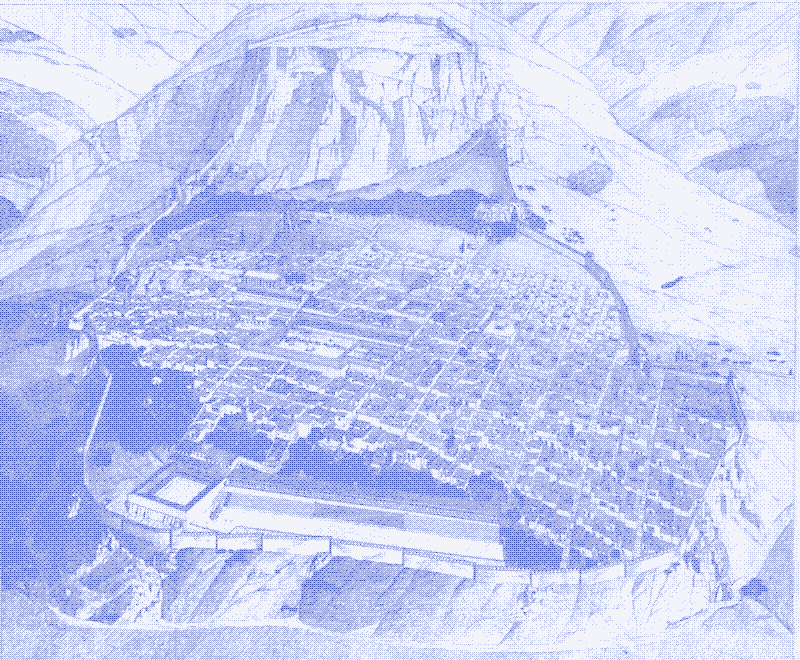
Another obvious example of Ancient Greek solar planning was Priene (illustration above), rebuilt in 350 BC and located in present-day Turkey. The city had about 4000 inhabitants living in 400 houses. Its buildings and street plan were similar to those in Olynthus, but because the city was built on the slope of a steep mountain, many of the fifteen secondary streets (running north-south) were actually stairways. The seven main avenues were terraced on an east-west axis.
Native Americans
The Ancient Pueblo People or “Anasazi” built a number of sophisticated solar oriented communities during the 11th and 12th centuries AD in what is now the Southwestern United States: Long House at Mesa Verde, Pueblo Bonito in Northern Mexico and the “sky city” of Acoma.
These communities followed a different building style than that of the Greeks. The Ancient Pueblo People constructed terraced buildings of up to three floors high. These were buildings that would fit perfectly in a solar envelope with slanting lines.
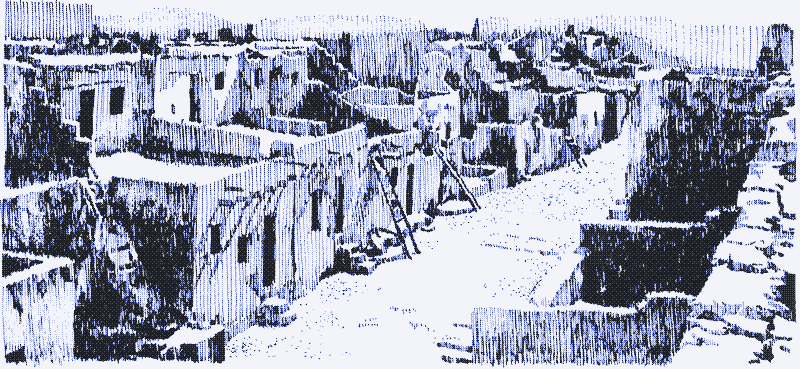
Acoma pueblo (illustration above) is one example of these orderly, solar planned communities. It consists of three rows of houses built along streets running east and west, so that each building faces south. The streets that separate the houses have a width that allows winter shadows to cover the whole of the adjoining street, stopping just before the following row of buildings.
Heliodon
Knowles’ research combines the best elements of these historical designs and incorporates modern technology that greatly facilitates the generation of a solar envelope. The heliodon, invented in the 1930s, is a contraption that creates a geometrical relationship between an architectural scale model and (a representation of) the sun. More recently, software versions of the heliodon have made the technology much more affordable, while allowing for the fast generation of even very complex solar envelopes.
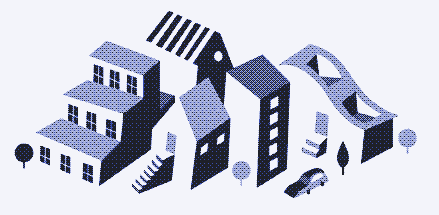
On larger sites in particular, and when already existing buildings complicate the generation of a solar envelope, the available computer software saves time and can result in more building volume.
Sources
- “Ritual House: Drawing on Nature’s Rhythms for Architecture and Urban Design”, Ralph L. Knowles, 2006.
- “Sun Rhythm Form”, Ralph L. Knowles, 1981
- “Energy and Form: An Ecological Approach to Urban Growth”, Ralph L. Knowles, 1974
- “A Golden Thread: 2500 Years of Solar Architecture and Technology”, Ken Butti and John Perlin, 1981, reprinted in 2009
- “The orientation of buildings, or planning for sunlight”, William Atkinson, 1912
- “Teoría general de la urbanización y aplicación de sus principios y doctrinas a la reforma y ensanche de Barcelona”, Ildefons Cerdà i Sunyer, 1867
- “Ildefonso Cerdá”, “Distrito del Ensanche” & “Plan Cerdá”, Wikipedia Spanish - “Walks Through Lost Paris: A Journey Into the Heart of Historic Paris”, Leonard Pitt, 2006
- “Responsive and sustainable architectural strategies for temperate regions”, S.M. Mofidi, 2005 (PDF) - “The City as a Work of Art: London, Paris, Vienna”, Donald J. Olsen, 1986
- “Spanish city planning in North America”, Dora Crouch, Daniel Garr, Axel Mundigo, 1982
- “The Density Atlas”, MIT (website) - “Visualizing density” (PDF)
Reactions
To make a comment, please send an e-mail to solar (at) lowtechmagazine (dot) com. Your e-mail address is not used for other purposes, and will be deleted after the comment is published. If you don’t want your real name to be published, sign the e-mail with the name you want to appear.
Reactions
Bill
Denver, Colorado was originally developed using the method described by Atkinson, since there was no method but solar for melting the copious snow the city received. As it grew, the traditional north-south grid was used… which to this day requires much more cost and effort to clear in the winter. Search Google: “maps denver central business district”
Tom
I thought I ought to mention that John Snow, not Richard Snow, was name of the physician who discovered the source of a cholera outbreak in London in 1854.
Kris De Decker
@ Calvin: see comment #8. The answer to your question depends on many factors. I agree that this should be researched, but to date this research is not available. I could do it myself, but I can’t do everything at the same time.
Of course some people will read this as an ad for mass architectural rebuilding – as they would read anything like an ad for mass architectural rebuilding. The fact is that we are still building many new houses and cities on virgin land, without any regard for solar orientation. Let’s first design these new neighbourhoods and cities for solar access, and then we can start talking about rebuilding what we already have.
By the way, many old buildings are relatively well adapted to the local climate, especially in sunny climates. It’s most of the modern architecture that would be completely uninhabitable in a world with limited access to fossil fuels. We will have to rebuild these anyway. And rebuilding should not be a negative thing: some companies are specializing in taking buildings apart without destroying the components, which can then be re-used.
Tim
I grew up in Southern California, and I could never figure why the old centers had grids that tilted off the cardinal points (Los Angeles, Downey, Anaheim, the oldest part of Santa Ana, and many others).
Now I finally have an answer. Thanks!
Manoj
I love to read the detailed articles on low tech magzine. In this article one thing I could not get though is amount of saving possible. For ex: If a block with similar density is build with solar envelop how much energy in % will be saved compared to block without solar energy.
Chris Hall
Great article Kris - really enjoyed the perspective and detail.
YvesT
Thanks a lot for the info Kris, will try to get one of them
Val Zacharias
There is a wooden palace in Bangkok, formerly the residence of the King. It stays very cool without any air conditioning, in spite of 99 degrees F heat and 99% humidity. It is 20 years since I saw it, but it is probably still there as a tourist attraction.
drs
A friend I shared this with brings up an issue: deserts support flat roofs happily enough, but houses in climates heavy in rain and snow (maybe mostly snow) tend to have sloped roofs (though big buildings often don’t.) Most of the pictures of terraces are of layers of flat roofs; some thought to “we got four feet of snow” design might be given.
William
The Japanese version of passivehaus, called OM Solar, uses the rooftop as a heat collector, rather than the windows. This would seem an easier fit for cities as only the very top of the building needs guaranteed solar access.
There’s a website describing it:
http://www.alatown.com/?p=235
Very good for roof integrated solar too i should think, as it meets a panel’s need for circulating air to cool it.
Joe A
I think many of the US Parks welcome center buildings are designed in this way. The ones that are usually have a sign that explains the reason for the sloped roof and the large windows that face the sun in the Winter.
Jonathan
Thought provoking article, though scant attention is paid to the situation of those of us in deserts. My cooling costs during the long, hot summers are considerably higher than my heating costs during the short, mild winters. I assume that orienting houses towards the northeast may help, but then again, it would be helpful to see that situation considered.
Calvin
The energy consumption per capita in most countries is well documented.
Equally so, Professor Knowles and/or his students should be able to provide concrete numbers as to how much more efficient their proposed building styles/plans are vs. existing methods.
The delta between the per capita existing consumption and the efficiency improvement percentage times the average solar panel install would yield at least a first order approximation as to what the contribution of architectural style might be.
As for old buildings - frankly this is a completely unsupported statement. The reality is even a theoretically well planned subdivision can easily be disharmonized by a few players. One owner of a single story on one equally sized piece of land in a solar optimized development would still be perfectly within his/her rights to build upward - in the process denying neighbors the previously free access to solar energy.
Thus an architectural plan itself is insufficient. Access to solar energy must equally be regularized under property law. Equally the optimal harvest of solar energy could only be accomplished via central state planning - which in turn deprives the individual property owners of significant free will. Both of these areas are fraught with potential for abuse, as sub surface mineral rights, water rights, navigation rights, and numerous other cross property rights battles have demonstrated.
Peter B.
I’d like to note that the surface of a solar-enveloped building is bigger, and heat loss is proportional to surface. It would be interesting to know what are the ratios to existing buildings.
There could also be an aesthetics depate on whether this zig-zag street views are good or not. To me it seems like the sea holiday town Jesolo, where it felt like lost in an endless city, as the buildings gave no orientation where we are. Designers of such city grids / blocks / houses should take extra care on blending it with the rest of the city.
mark schuette
Great subject. although the concept of doing this on a mass planned scale is unrealistic considereing the low level of education and environmental concern in the general population and political scene.
the Passive solar science was quantified (documented via measurement and software developed to predict it) back in the late 70’s by Los Alamos scientific labs (of atomic bomb fame)and the surrounding progressive builders in Santa Fe, NM.
but on an individual basis it makes soooo much sense. some reidential homes are built as net zero energy homes meaning they use no energy from exterior sources. AND they are conventional design with PV panels added- think of what we could do by paying attention to Passive Solar heating and cooling on top of that ! our buildings are our biggest energy users. its so simple and easy to do. its sick that we can’t even do this. we are so hung up on some antiquated concept of aesthetics. Functionality is the new aesthetics! STILL most of the new buildings ignore these simple design principals. we will have to crash again and become poorer before we bet out of our cheap dirty energy box.
Cezar
Hi,
Both new built and existing densely populated neighbourhoods could benefit from underground annual energy storage, that means collecting heat in the summer and using it in the winter for heating.
Technology is quite simple and has a good economy of scale by servicing many houses or flat apartments with one borehole thermal storage system.
Other than thermal solar panels, a source of heat can be local electrical plants that are used for district heating in the winter. They do provide hot water in the summer too, but that’s a small fraction of the heat released from fueled electricity production. Unwderground storage could allow recovery of full year wasted heat from city powerplants.
Here-s an example of such a system providing 97% solar heating requirement in Canada http://en.wikipedia.org/wiki/Drake_Landing_Solar_Community